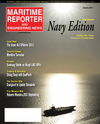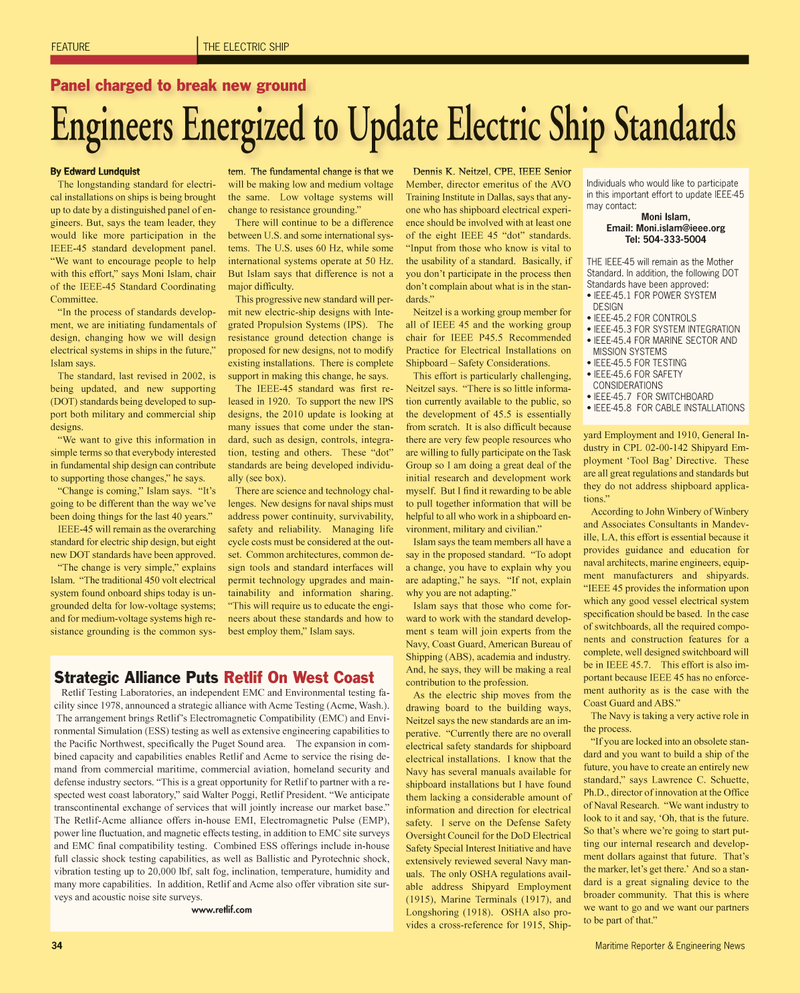
Page 34: of Maritime Reporter Magazine (January 2011)
International Naval Technology
Read this page in Pdf, Flash or Html5 edition of January 2011 Maritime Reporter Magazine
By Edward Lundquist
The longstanding standard for electri- cal installations on ships is being brought up to date by a distinguished panel of en- gineers. But, says the team leader, they would like more participation in the
IEEE-45 standard development panel. “We want to encourage people to help with this effort,” says Moni Islam, chair of the IEEE-45 Standard Coordinating
Committee. “In the process of standards develop- ment, we are initiating fundamentals of design, changing how we will design electrical systems in ships in the future,”
Islam says.
The standard, last revised in 2002, is being updated, and new supporting (DOT) standards being developed to sup- port both military and commercial ship designs. “We want to give this information in simple terms so that everybody interested in fundamental ship design can contribute to supporting those changes,” he says. “Change is coming,” Islam says. “It’s going to be different than the way we’ve been doing things for the last 40 years.”
IEEE-45 will remain as the overarching standard for electric ship design, but eight new DOT standards have been approved. “The change is very simple,” explains
Islam. “The traditional 450 volt electrical system found onboard ships today is un- grounded delta for low-voltage systems; and for medium-voltage systems high re- sistance grounding is the common sys- tem. The fundamental change is that we will be making low and medium voltage the same. Low voltage systems will change to resistance grounding.”
There will continue to be a difference between U.S. and some international sys- tems. The U.S. uses 60 Hz, while some international systems operate at 50 Hz.
But Islam says that difference is not a major difficulty.
This progressive new standard will per- mit new electric-ship designs with Inte- grated Propulsion Systems (IPS). The resistance ground detection change is proposed for new designs, not to modify existing installations. There is complete support in making this change, he says.
The IEEE-45 standard was first re- leased in 1920. To support the new IPS designs, the 2010 update is looking at many issues that come under the stan- dard, such as design, controls, integra- tion, testing and others. These “dot” standards are being developed individu- ally (see box).
There are science and technology chal- lenges. New designs for naval ships must address power continuity, survivability, safety and reliability. Managing life cycle costs must be considered at the out- set. Common architectures, common de- sign tools and standard interfaces will permit technology upgrades and main- tainability and information sharing. “This will require us to educate the engi- neers about these standards and how to best employ them,” Islam says.
Dennis K. Neitzel, CPE, IEEE Senior
Member, director emeritus of the AVO
Training Institute in Dallas, says that any- one who has shipboard electrical experi- ence should be involved with at least one of the eight IEEE 45 “dot” standards. “Input from those who know is vital to the usability of a standard. Basically, if you don’t participate in the process then don’t complain about what is in the stan- dards.”
Neitzel is a working group member for all of IEEE 45 and the working group chair for IEEE P45.5 Recommended
Practice for Electrical Installations on
Shipboard – Safety Considerations.
This effort is particularly challenging,
Neitzel says. “There is so little informa- tion currently available to the public, so the development of 45.5 is essentially from scratch. It is also difficult because there are very few people resources who are willing to fully participate on the Task
Group so I am doing a great deal of the initial research and development work myself. But I find it rewarding to be able to pull together information that will be helpful to all who work in a shipboard en- vironment, military and civilian.”
Islam says the team members all have a say in the proposed standard. “To adopt a change, you have to explain why you are adapting,” he says. “If not, explain why you are not adapting.”
Islam says that those who come for- ward to work with the standard develop- ment s team will join experts from the
Navy, Coast Guard, American Bureau of
Shipping (ABS), academia and industry.
And, he says, they will be making a real contribution to the profession.
As the electric ship moves from the drawing board to the building ways,
Neitzel says the new standards are an im- perative. “Currently there are no overall electrical safety standards for shipboard electrical installations. I know that the
Navy has several manuals available for shipboard installations but I have found them lacking a considerable amount of information and direction for electrical safety. I serve on the Defense Safety
Oversight Council for the DoD Electrical
Safety Special Interest Initiative and have extensively reviewed several Navy man- uals. The only OSHA regulations avail- able address Shipyard Employment (1915), Marine Terminals (1917), and
Longshoring (1918). OSHA also pro- vides a cross-reference for 1915, Ship- yard Employment and 1910, General In- dustry in CPL 02-00-142 Shipyard Em- ployment ‘Tool Bag’ Directive. These are all great regulations and standards but they do not address shipboard applica- tions.”
According to John Winbery of Winbery and Associates Consultants in Mandev- ille, LA, this effort is essential because it provides guidance and education for naval architects, marine engineers, equip- ment manufacturers and shipyards. “IEEE 45 provides the information upon which any good vessel electrical system specification should be based. In the case of switchboards, all the required compo- nents and construction features for a complete, well designed switchboard will be in IEEE 45.7. This effort is also im- portant because IEEE 45 has no enforce- ment authority as is the case with the
Coast Guard and ABS.”
The Navy is taking a very active role in the process. “If you are locked into an obsolete stan- dard and you want to build a ship of the future, you have to create an entirely new standard,” says Lawrence C. Schuette,
Ph.D., director of innovation at the Office of Naval Research. “We want industry to look to it and say, ‘Oh, that is the future.
So that’s where we’re going to start put- ting our internal research and develop- ment dollars against that future. That’s the marker, let’s get there.’ And so a stan- dard is a great signaling device to the broader community. That this is where we want to go and we want our partners to be part of that.”
FEATURE THE ELECTRIC SHIP
Panel charged to break new ground
Engineers Energized to Update Electric Ship Standards
Individuals who would like to participate in this important effort to update IEEE-45 may contact:
Moni Islam,
Email: [email protected]
Tel: 504-333-5004
THE IEEE-45 will remain as the Mother
Standard. In addition, the following DOT
Standards have been approved: • IEEE-45.1 FOR POWER SYSTEM
DESIGN • IEEE-45.2 FOR CONTROLS • IEEE-45.3 FOR SYSTEM INTEGRATION • IEEE-45.4 FOR MARINE SECTOR AND
MISSION SYSTEMS • IEEE-45.5 FOR TESTING • IEEE-45.6 FOR SAFETY
CONSIDERATIONS • IEEE-45.7 FOR SWITCHBOARD • IEEE-45.8 FOR CABLE INSTALLATIONS
Strategic Alliance Puts Retlif On West Coast
Retlif Testing Laboratories, an independent EMC and Environmental testing fa- cility since 1978, announced a strategic alliance with Acme Testing (Acme, Wash.).
The arrangement brings Retlif’s Electromagnetic Compatibility (EMC) and Envi- ronmental Simulation (ESS) testing as well as extensive engineering capabilities to the Pacific Northwest, specifically the Puget Sound area. The expansion in com- bined capacity and capabilities enables Retlif and Acme to service the rising de- mand from commercial maritime, commercial aviation, homeland security and defense industry sectors. “This is a great opportunity for Retlif to partner with a re- spected west coast laboratory,” said Walter Poggi, Retlif President. “We anticipate transcontinental exchange of services that will jointly increase our market base.”
The Retlif-Acme alliance offers in-house EMI, Electromagnetic Pulse (EMP), power line fluctuation, and magnetic effects testing, in addition to EMC site surveys and EMC final compatibility testing. Combined ESS offerings include in-house full classic shock testing capabilities, as well as Ballistic and Pyrotechnic shock, vibration testing up to 20,000 lbf, salt fog, inclination, temperature, humidity and many more capabilities. In addition, Retlif and Acme also offer vibration site sur- veys and acoustic noise site surveys. www.retlif.com 34 Maritime Reporter & Engineering News

 33
33

 35
35
